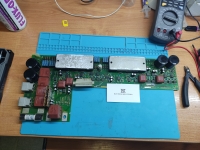Static electricity

A daily occurrence called electrostatic discharge (ESD). It occurs as a result of the accumulation of positively charged particles on the surface of an object. When transferring an electric charge between any two objects, for example, when rubbing synthetic surfaces, surfaces of PVC film. The most common cause is a lack of grounding between two dissimilar materials, causing electrical charges to build up on their surfaces. It is not uncommon for a human body to be one of the surfaces. A typical example of this is the static discharge that a person experiences after walking on a carpet and then touching a metal object. The discharge is accompanied by a painful sensation at the point of contact and, as a rule, is accompanied by small sparks and clicks, while the potential value can reach 15 kV. And if a 6 kV discharge is painful for a person, then lower values, although they may go unnoticed, can nevertheless cause irreversible damage to electronic components and circuits or lead to the appearance of hidden and floating defects that do not manifest themselves immediately, during operation. devices. Thus, ESD phenomena pose a serious threat to electronic devices that lack ESD protection. The technological possibility of using certain means of protection to reduce or eliminate their impact has existed for more than a dozen years, saving 1000 units of electronic devices from this phenomenon.
The difference between ESD and other transients, such as switching, various switching faults, etc., is the extremely short transient time: the build-up of electrostatic discharge occurs in less than 1 nanosecond, while the time to peak for most of the most typical transients is more than 1 microseconds.
ESD standards
Today, there are several standards for ESD protection that are most often used by manufacturers: EN100015, EN61340-5-1 and ANSI / ESD 20:20. EN61340-5-1 has now superseded EN100015 and is the main standard in Europe. ANSI / ESD 20:20 is used primarily in North America. Many manufacturers work with both EN61340-5-1 and ESD20: 20 (both standards are largely compatible) and sometimes use other standards as well.
In the Russian Federation, there are standards approved by the Federal Agency for Technical Regulation and Metrology and developed in 2009 on the basis of EN61340-5-1 by the Russian Technical Committee TK072 "Electrostatics". This is GOST R 53734.5.1-2009 “Electrostatics. Part 5-1: Protection of electronic devices from electrostatic phenomena. General requirements "and GOST R 53734.5.2-2009" Electrostatics. Part 5-2: Protection of electronic devices from electrostatic phenomena. User guide".
Services
- Repair and maintenance of frequency converters
- Repair of servo controllers
- Repair of servo-controllers
- Machine control panels
- Panels operators
- Repair of industrial programmers
- Repair of flaw detectors
- Repair of transmitters and transmitters
- Repair of verification stands
- Laser installations
- Repair of Bosch Praesideo audio warning systems
- Automated Bosch Security Systems
- Machine Vision Systems
- PROFI BUS gateway systems
- Industrial computers repair and maintenance
- Repair of industrial robots
- Repair of industrial equipment
- Equipment commissioning
- Premium service
- Modernization of CNC machines
- Development of robotics for small and medium-sized industrial classes
- Repair of controllers and control modules
- Repair of controllers and control modules
- Repair of controllers and control modules



